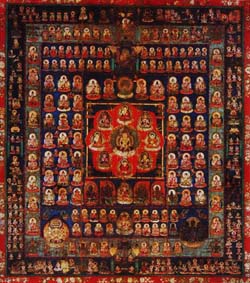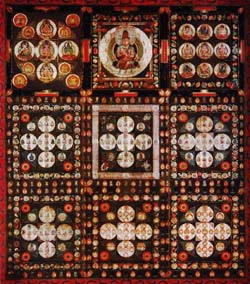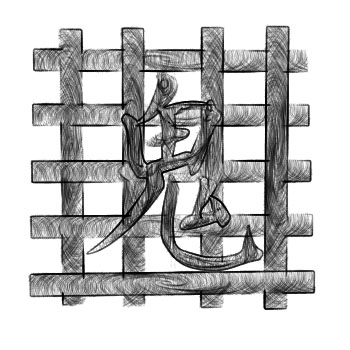Sanmitsu
Mandala
Mandala means nenriki in Japanese and is concentrated intention. The mandala symbolizes the will of the Ninja.
In the ninpō mikkyō there are two different ways of looking at the structure of the universe. Both are completely opposite, but only when both are practiced can insight be gained.
One possibility is to look at the course of the universe from the inside, i. H. one concentrates on the physical phenomena and tries to gain an understanding from that point of view.
Taizokai Mandala

To comprehend the material world, the world of breeding ground, the Ninja can look at the Taizokai mandala and contemplate the meaning of the work of art.
He will come to realize that everything exists within this one universe. All the galaxies, star clusters, star systems, stars, planets, animals, people, words, colors, shapes, and thoughts. Everything we accomplish during our lives influences this cycle and is recognized because it takes place in God. Conversely, God is also present in each of these things. In this way, we get a better view of larger perspectives and may find that all opposites and paradoxes find their place in this universe.
The other way is to raise the mind above the universe, separate from I, and survey the whole universe. This is how one recognizes cosmic laws. One understands and comprehends the fine threads that are tied between all things in the universe, the dependencies among one another.
Kongokai Mandala

To comprehend the spirit world, the world of diamond, the Ninja can look at the Kongokai mandala. The diamond in this case represents hardness, clarity, and pure knowledge, the ultimate truth.
The Ninja will come to realize that this reality is only the subjective view of what is real. Everything around us has only the form that our cosmic laws give it and shape our consciousness. Leaving behind the material world and experiencing the cosmic laws, one attains kanjinkaname, the Mind, and Eyes of God. In this way, one can look down on the earth from a higher, enlightened level.
However, you must practice both ways of looking at things, because otherwise, an imbalance will arise. So the art of Ninjutsu can degenerate into a purely mechanical and technical combat system without spirit, or you lose touch with reality, become unworldly, and feel elevated and above everything.
Mantra
Mantra means jumon in Japanese and is the charged word. The mantra symbolizes the intellect. Words and actions alone are nothing. Only when the germinating thought behind it can be recognized as the motive are they effective. The charged word is the continuation of thought as a word. The words used by the Ninja are mostly still in their original language or, if translated, without a specific meaning. In tantra, it is believed that certain sounds can influence the process of the universe. The exact functionality has not yet been scientifically clarified, but many of the mantras are very pure in their vibration rates and harmonize with the frequencies of the physical realities.
A simple example is the primal sound Ohm when you first open your mouth wide and make an ah sound. Without change, the mouth is closed, resulting in an oh sound and then an m sound. Finally, the tongue is pressed against the incisors, resulting in an n sound. So the sound sequence is Ah-oh-mm-nn. This sound closely resembles the Christian prayer sound Ahmen. However, these exercises are very special, so you can learn them on your own. Many aspects such as pitch, breathing rhythm, and voice quality contribute to the result. One should consult a qualified master if one is interested in mantras.
Mudra
Mudra means ketsuin in Japanese and is the hand position. The mudra symbolizes physical action.
The kuji in hand signs are the third secret of sanmitsu. Its origin can be found in the countless hand positions from India.
As with acupuncture, certain meridians are likely to be stimulated with these hand positions. Many ends or turning points should be found especially in the hands. Only nine of these hand positions have been transferred to Ninjutsu. These are: rin (臨), pyō (兵), tō (闘), sha (者), kai (皆), jin (陣), retsu (列), zai (在), zen (前). These are the mantras for each hand position. Each of these hand positions symbolizes a goal worth striving for, which turns from thought to word to action. The whole organism is brought into this state of harmony and the Ninja feels as if the result has already been achieved, it is just waiting for it to show up on the physical plane.
These hand positions have no effect if you just fold them like that. It takes many years of intensive training with an experienced master to feel the effects. Not like the Hollywood movies would have us believe: when you’re hurt, you just sit in a corner, tie your hands in a knot, and the healing is complete.
Kuji kiri
The kuji kiri does not belong to the sanmitsu but is mentioned here for information. It is very closely related to kuji in, however, most people confuse the two. Both were probably introduced to Japan with Buddhism.
The kuji kiri or kuji goshin hō is said to originate from the god-like warrior guard Marishiten. This esoteric formula of power is used to overcome evil, illusion, ignorance, or weakness and to strengthen the Ninja.
The Ninja mimics the flaming sword of the fudōmyō, the fearsome mythical protector of the will, law, and integrity of the universe.

The right, positive, and left, negative hands are brought together in front of the chest to represent the sword. An incantation is repeated several times, and then the Ninja steps forward and draws alternate horizontal and vertical cuts in the air with his symbolic sword. The spiritual blade is moved alternately from left to right and up and down until the nine cuts form a grid. The Ninja speaks the nine syllables of kuji goshin hō. A further tenth syllable can be added at will before the lattice is severed with a handshake and the symbolic sword is inserted back into the saya.
Fishermen liked to add the syllable for water as the tenth sign in the lattice, which they drew on paper for protection and safe travel. Ninja could for example add the symbol for a demon to scare and terrify enemies. As with the kuji in, these techniques are included for information only. Without the right teacher, long practice, the right breathing rhythm, and mental focus, practicing kuji kiri has no effect.